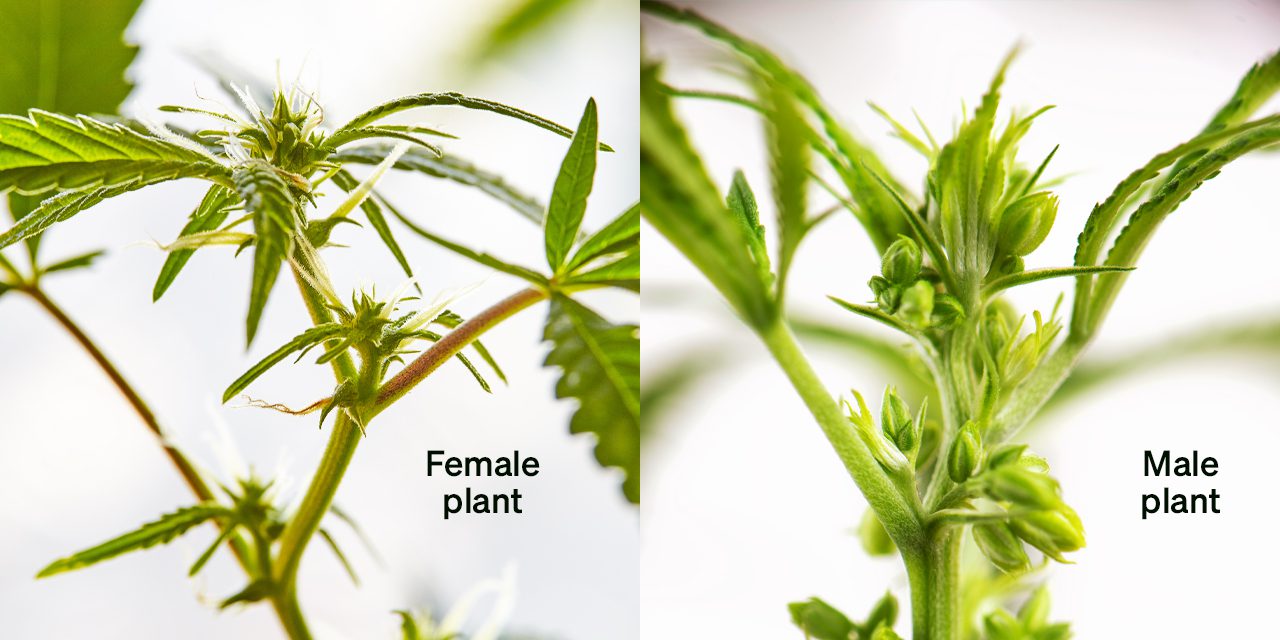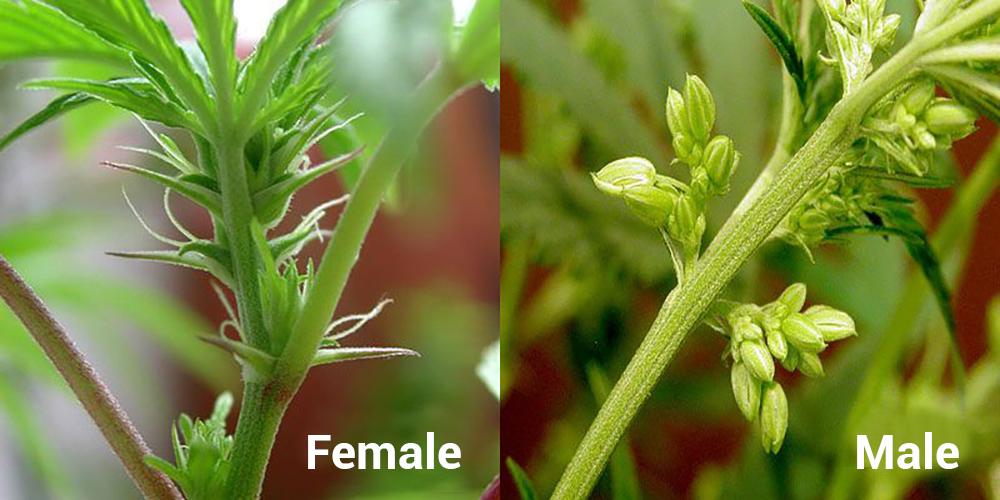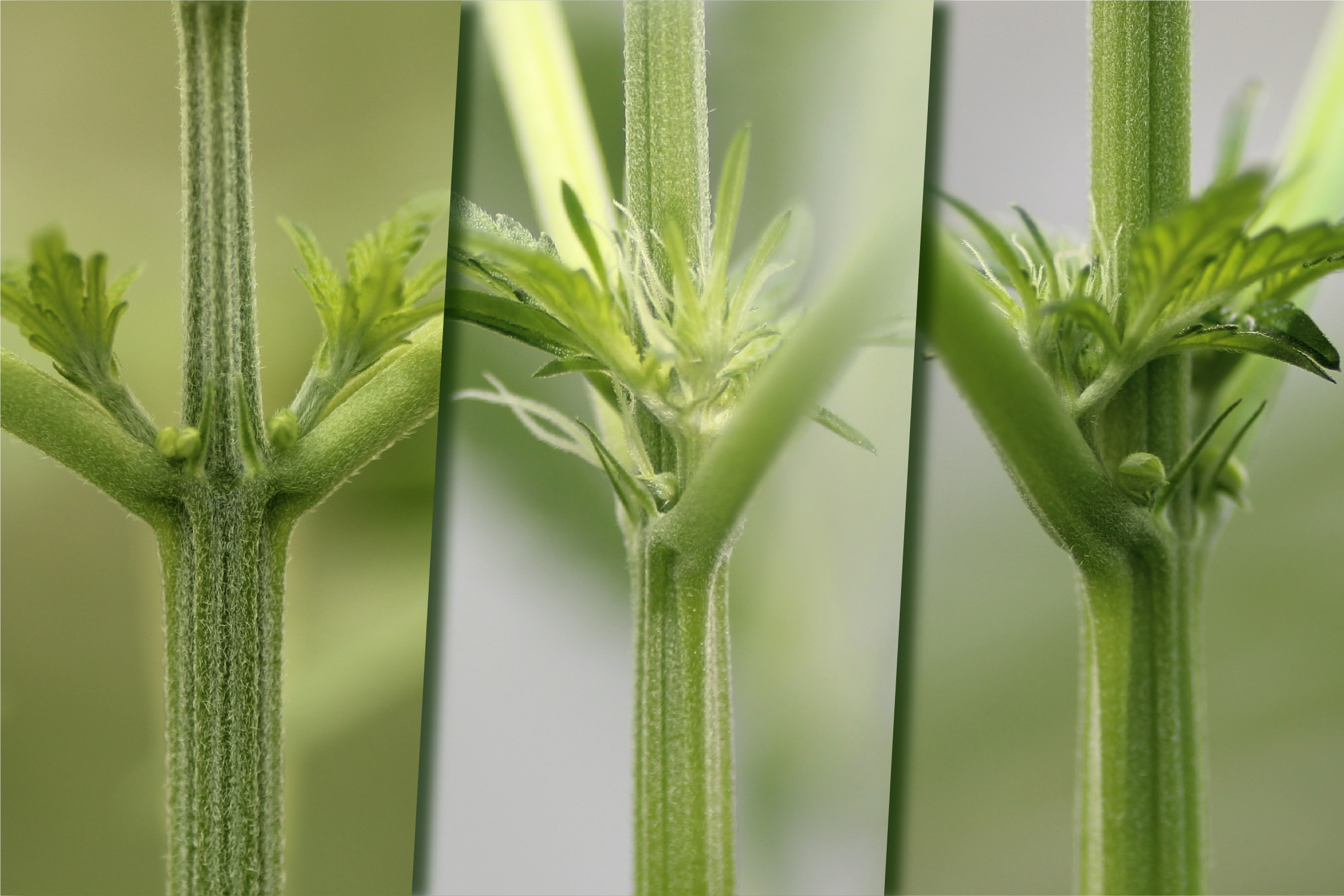Why Does It Matter That Cannabis Is Dioecious?
Cannabis plants display sexual dimorphism, meaning they feature distinct characteristics between the sexes. This is what makes them dioecious plants; male and female plants are genetically different.
The importance of this genetic difference is in giving growers control over their crops. Male and female plants can be separated so that females do not get fertilized by males, thus preventing the flowers from going to seed or producing low-quality buds.
They also provide breeders with an opportunity to selectively cross desirable specimens – those that exhibit desired traits – and create unique strains and hybrids from the resulting progeny.
Growers can look for healthy specimens with strong genetic backgrounds that will deliver high yields, extreme flavors, and aromas, as well as other sought-after attributes.
Male vs. Female Cannabis: What's The Difference?
Male and female cannabis plants look identical in the early stages of growth. However, during the flowering phase, the differences between them become apparent. Cannabis females are what are typically grown by recreational growers due to their production of resinous buds loaded with cannabinoids while males form pollen-filled sacs.
Each female plant is unique, from genetics determining size and plant structure to how much lateral growth they will produce. For example, some female plants remain smaller than others yet still manage to create dense canopies of flower buds whereas other varieties may grow larger with larger bud sets and bigger yield potentials.
Regardless, female plants offer personal growers an opportunity to cultivate their desired effects within a harvestable bounty of buds. The decision to pursue growing either male or female cannabis should be considered carefully before beginning such a project as the successful cultivation of either one requires expert knowledge and skillset.
Females will require pruning to provide light levels where they need to go so that each plant can reach optimal growth potential while maintaining sensible environmental conditions for healthy development. Males on the other hand have one main purpose which is pollinating female flowers once they have been identified as such by growers through observation of pre-flowering clues such as calyx morphology.
Hermaphrodites: When Cannabis Plants Become Monoecious
Hermaphrodite plants can be mysterious and misunderstood, but this is not just the case with humans. Cannabis plants sometimes go against the grain and develop reproductive organs of both genders, becoming hermaphrodites.
It's unclear whether genetic or environmental factors are to blame or a mix of both, but these specimens end up growing both buds and pollen sacs, allowing them to pollinate themselves. Growers looking for good-quality flowers need to be aware of the possibility of hermaphrodites in their crops so they can take steps to reduce it.
Can You Tell if Your Plant Is Male or Female Before Flowering?
Spotting the gender of your cannabis plants before they enter the flowering stage has become an important skill for any grower in pursuit of high-quality resinous buds. By learning what to look for, you can prevent male plants from entering your grow room and save yourself time and energy that would otherwise be wasted on growing a plant that will never bear smokable bud.
Although it takes some time—up to six weeks—for pre-flowers to develop enough to display obvious male and female features, it is still possible to tell the sex of your plant before it starts flowering.
Once your plant reaches the pre-flowering stage, observe closely around its nodes as this is where male and female flowers develop first. Male plants will typically show their gender by way of ball-shaped pollen sacks while female marijuana plants tend to form small white hairs known as pistils.
Once you have identified which gender pattern your plant is exhibiting then you can pick either keep the females and remove the males or take cuttings for later use if necessary.
Pay close attention and carefully note when each new preflower appears so you can make sure you’re not letting any unwanted males slip through into the next stages of development!
How To Identify Different Sexes Of Cannabis Plants: Sexing Cannabis
Knowing how to identify the sex of a cannabis plant is instrumental to successful growth and yields. As a cannabis grower, you need to understand how the different sexes manifest in marijuana plants. The sex of your plants will determine when and how they flower, as well as other various details that can truly make or break your growing process.
More: Ever wondered why is cannabis so colorful?
Identifying a Male Cannabis Plant
Identifying a male cannabis plant can be challenging because it initially looks similar to the female pre-flower. However, the male will have a more round shape resembling a spade from playing cards.
As it grows slightly larger, the male pre-flower will look like a ball resting atop a stick. At this point, the male is referred to as a staminate and will eventually develop into a long sack of baby banana-shaped pollen sacs.
The key distinguishing trait between male and female weed plants is that once you recognize the male pre-flower, it is important to remove it before the plant reaches maturity. If left in high-stress environments or around other mature males, pollen sacks may form prematurely, leading to accidental pollination that affects yield and quality of product
Identifying a Female Cannabis Plant
Identifying a female cannabis plant is an important step in successful marijuana cultivation. Female weed plants produce what we know as the flower, so it’s essential to differentiate them from the male plants early on to restrain any cross-pollination that could potentially ruin your future yield.
The very early pre-flowers of female cannabis plants are typically more ovate; often likened to that of a pear, with a longer and slender pointed tip. These pre-flowers appear at the junction of the stem and leaves and present a calyx and sometimes what appear to be white hair-like protrusions which are pistils.
It’s important to note not all feminized plants will produce these pistils during their pre-flower stage and even if you are fairly certain about the sex of your plant, it’s a relatively safe decision to wait for further evidence both for general prosperity and prevention of mistaken gender identification.
Other common factors such as flower formation, leaf shape, size differences, and color display between male and feminized plants can also help distinguish between sexes in order to make optimal choices for effective cultivation.
Other Common Differences Between Male and Female Cannabis Plants
When it comes to differentiating between male and female cannabis plants, there are several potential distinctions worth noting. Male plants tend to be much taller, with fewer fan leaves and a greater inter-nodal spacing between branches.
This makes them thin and gangly in comparison to the more compact, bushier structure of their female counterparts. In some cases, this can give you an indication that you’re dealing with a male plant, although it should not be the only way used to sex cannabis plants since local variations among strains and phenotypes can lead to unexpected results.
To better cultivate strong cannabis plants – and eventually stronger buds – growers should pay attention to several factors apart from gender distinction. Features such as sunlight exposure, water distribution, nutrient balance, genetics, and general environmental conditions all play roles in how well a cannabis plant will perform. Understanding these elements is the best way for growers to get great yields of both males and females.
Can You Tell the Sex of a Cannabis Seed?
We wish we could tell you that you can distinguish the sex of a cannabis seed by simply looking at it in its natural state, but unfortunately, that’s not the case. Believe it or not, even the most experienced ganja growers are often surprised to discover the gender of their mature plants when they harvest them.
That’s because feminized seeds don’t display any anatomical features that can give away any clues about their sex. Without key structures such as preflowers, leaves, and stems to accurately assess, a cannabis seed is nothing more than an encapsulated version of Its potential genetics.
That Is How You Determine The Sex Of Cannabis Plants
The first step in telling the sex of cannabis plants is to first learn about the male and female reproductive systems. The male reproductive system consists of pollen sacs, which contain the pollen that pollinates the female flowers, while females produce pistils which are long hairs where pollen is deposited. To be sure of the plant sex you can look for these two distinct features.
Knowing how to determine the sex of a cannabis plant is essential if you want to choose between growing feminized or regular cannabis seeds. Feminized marijuana seeds produce plants that are less likely to develop male flowers since they are bred using female plants only.
On the other hand, regular seeds may have any combination of males and females depending on their genetic makeup. You can use methods such as flowering or taking a sample for testing to properly differentiate between male and female plants before planting your crop.
With some patience, observation, and determination you will soon be able to easily identify sexes so that you can start harvesting buds from your cannabis garden!


 Français
Français 

